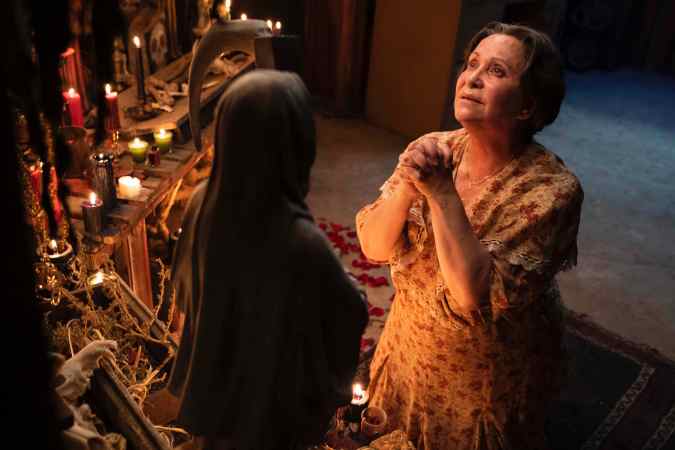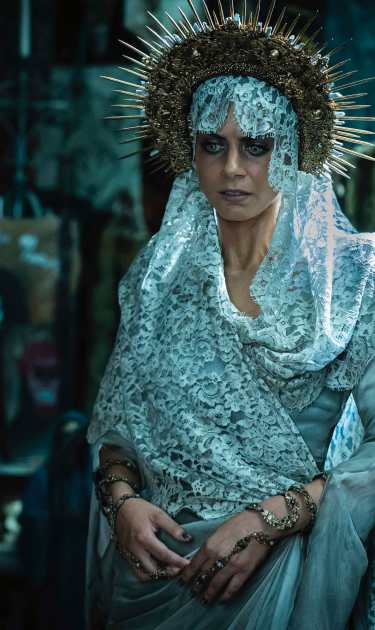“Mijo, what’s wrong with those kids who wear black all the time and look like they have a lot of feelings?” Living the goth/emo life in Texas takes dedication; trying to explain why kids would intentionally choose to wear black and mope around in the sun’s heat to my mom was like trying to learn Calculus: theoretically it makes a whole lotta sense but it isn’t really useful to me in the practical. Penny Dreadful: City of Angels‘s rendition of La Muerte is a lot like a goth kid in the 90s, unmotivated and always copping an attitude if you ask them to do something.
Let’s face it, when it comes to communities of color and Latinx communities specifically, the magical brown people trope is the standard go to — along with the maid/cook, the coconut, the gangster, the social activist farmworker. In this series, you get all of them in one family. Adriana Barraza plays Maria Vega, the matriarch of the family, while Daniel Zovatto and Adam Rodriguez play Tiago and Raul, dueling brothers, one a cop, the other a rebel-rousing activist. Set in the 1930s, the show alleges to put Mexican folklore at its heart with Santa Muerte playing a key role in the Vega family story. As a magical brown man myself, I was hyped to see where this whole thing was going and how they would portray La Señora
Trust me, as a writer I get it, how do we both tell stories and create devices and characters to move narratives forward? What story are we trying to tell, how are we telling it, and to whom? The problem with fantastical realism through the lens of the white gaze is that it creates distance rather than bridging it. It sees magic as a device to move the story’s agenda forward instead of as an invisible character interacting within it. And that, to me, is at the heart of this “heartless” Santa Muerte. She is all ornamentation without any of the alma. She has become, we could say, La Emo Muerte.
“La Huesera,” the Bone Woman, emerged as the folk-saint we now know in the barrios of Tepito in Mexico City during the late 50s and early 60s. While her faces and iterations draw from Mexico and Central America’s pre-Columbian past, she is a divinity of her mid-century era. Born from the anguish and suffering of Mexico’s most invisible and marginalized peoples — indigenous, working-class, and Afro-Mexican communities — Santísima took the symbols of colonization and turned them on their head. She proclaimed to those in power — the rich, light-skinned, and “well educated” — that she saw everything. While they could try and abuse her people here in the world of the living, that shit ain’t going to fly in the lands of the dead. She centers the prayers of the most needy with the least access as her top priority. In City of Angels, set in the 30s, though, we encounter her fully formed, as if she had always existed in that guise.

Penny Dreadful creates an aesthetically beautiful Santísima, bringing her visually to life (with much artistic license). From the white lace of her huipils to her golden crown of skulls and bones, she is rendered with all the flair but none of the substance. She is an emaciated death, not the conquering majesty of eternity. La Muerte’s usual companions — the scythe, owl, spiders, and bats — have been substituted for a snarling coyote head hung from the corner of a dank prayer shack. Rather than adorn the Mother of the Dead’s space with beauty, the show consigns her to dark, unwelcoming spaces.
She is relegated, as all misunderstood beings are, to the liminal; the night. The care given to her face is not the same presence of how Santísima speaks through it. Instead of death shrouds and prayer shawls that liberate the soul from the land of the living, here they become chains that enslave and disempower her, literally restricting her from movement within the scenes. Where the haloed crown of gold is envisioned as the inner holiness and inherent value of people despite their castes, here it becomes a cheap tiara, a prop of self importance and aggrandizement. That’s not La Flaquita that I know and venerate. Who is this brooding emo lady?

From holy angels to devils, Penny Dreadful: City of Angels lays it on thick with Hollywood style brujería At one point we see Barraza’s maid/mother/witch in front of her shrines pleading for the protection of her family and community. I had my chancla in hand to throw at the screen because I was halfway expecting to see her bite off a chicken head while drums played in the background. These types of dramatizations tell us more about how the white gaze views Latinx spirituality and communities than it does about our actual lived experiences and practices. It might as well have been a scene out of any 80s horror voodoo movie.

And what really got my goat, outside of the casual mention of black masses happening in the city (how facile to equate Santa Muerte with Satan worship), was the phrase “peasant religions” as the descriptor and context of La Muerte’s veneration. The implication is clear: educated (aka white middle and landowning class) people would never deign to believe in such a thing. While I understand that the narrative is trying to juxtapose brujería against the other “weird community” of the Pseudo-Protestant-Holy-Roller temple as a way of illuminating the hypocrisy and racism inherent to each of their treatment within Los Angeles, it didn’t land that way. The difference is always who holds the power and whose reflection is being cast through the portrayal. The consumers here are not Latinxs. These are our stories merely being made into palatable bites for white audiences.
Penny Dreadful: City of Angels is well acted and highly entertaining but let’s not forget at whose expense we are being entertained. A better version of a minstrel show is still a minstrel show nonetheless. It may be powerful to see Chicanx history on the screen, but that is not my Flaca, my Muerte.
Penny Dreadful: City of Angels airs Sundays on Showtime.




